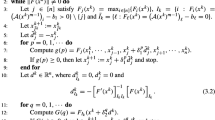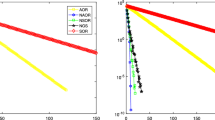Abstract
We consider multilinear systems of equations whose coefficient tensors are \({{\mathcal {M}}}\)-tensors. Multilinear systems of equations have many applications in engineering and scientific computing, such as data mining and numerical partial differential equations. In this paper, we show that solving multilinear systems with \({{\mathcal {M}}}\)-tensors is equivalent to solving nonlinear systems of equations where the involving functions are P-functions. Based on this result, we propose a Newton-type method to solve multilinear systems with \({{\mathcal {M}}}\)-tensors. For a multilinear system with a nonsingular \({{\mathcal {M}}}\)-tensor and a positive right side vector, we prove that the sequence generated by the proposed method converges to the unique solution of the multilinear system and the convergence rate is quadratic. Numerical results are reported to show that the proposed method is promising.




Similar content being viewed by others
Explore related subjects
Discover the latest articles and news from researchers in related subjects, suggested using machine learning.References
Bader, B.W., Kolda, T.G., et al.: MATLAB Tensor Toolbox Version 2.6. Available online (2015). http://www.sandia.gov/~tgkolda/TensorToolbox/
Benzi, M.: Preconditioning techniques for large linear systems: a survey. J. Comput. Phys. 182, 418–477 (2002)
Berman, A., Plemmons, R.: Nonnegative Matrices in the Mathematical Sciences. SIAM, Philadelphia (1994)
Brazell, M., Li, N., Navasca, C., Tamon, C.: Solving multilinear systems via tensor inversion. SIAM J. Matrix Anal. Appl. 34(2), 542–570 (2013)
Chang, K., Qi, L., Zhang, T.: A survey on the spectral theory of nonnegative tensors. Numer. Linear Algebra Appl. 20(6), 891–912 (2013)
Chen, H., Chen, Y., Li, G., Qi, L.: A semidefinite program approach for computing the maximum eigenvalue of a class of structured tensors and its applications in hypergraphs and copositivity test. Numer. Linear Algebra Appl. (2017). https://doi.org/10.1002/nla.2125
Ding, W., Qi, L., Wei, Y.: M-tensor and nonsingular M-tensors. Linear Algebra Appl. 439, 3264–3278 (2013)
Ding, W., Wei, Y.: Solving multilinear systems with M-tensors. J. Sci. Comput. 68, 689–715 (2016)
Facchinei, F., Kanzow, C.: Beyond monotonicity in regularization methods for nonlinear complementarity problems. SIAM J. Control Optim. 37(4), 1150–1161 (1999)
Facchinei, F., Pang, J.: Finite-Dimensional Variational Inequalities and Complementarity Problems. Springer, New York (2003)
Han, L.: A homotopy method for solving multilinear systems with M-tensors. Appl. Math. Lett. 69, 49–54 (2017)
Kressner, D., Tobler, C.: Krylov subspace methods for linear systems with tensor product structure. SIAM J. Matrix Anal. Appl. 31(4), 1688–1714 (2010)
Li, D., Xie, S., Xu, H.: Splitting methods for tensor equations. Numer. Linear Algebra Appl. (2017). https://doi.org/10.1002/nla.2102
Li, X., Ng, M.: Solving sparse non-negative tensor equations: algorithms and applications. Front. Math. China 10, 649–680 (2015)
Matsuno, Y.: Exact solutions for the nonlinear Klein–Gordon and Liouville equations in four-dimensional Euclidean space. J. Math. Phys. 28, 2317–2322 (1987)
Qi, H.D.: A regularized smoothing Newton method for box constrained variational inequality problems with \(P_0\)-functions. SIAM J. Optim. 10(2), 315–330 (2000)
Qi, L.: Eigenvalues of a real supersymmetric tensor. J. Symbolic Comput. 40(6), 1302–1324 (2005)
Qi, L., Luo, Z.: Tensor Analysis: Spectral Theory and Special Tensors. SIAM, Philadelphia (2017)
Qi, L., Sun, D., Zhou, G.: A new look at smoothing newton methods for nonlinear complementarity problems and box constrained variational inequalities. Math. Program. 87(1), 1–35 (2000)
Tobler, C.: Low-rank tensor methods for linear systems and eigenvalue problems. Ph.D. Thesis, Eidgenssische Technische Hochschule ETH Zrich, No. 20320 (2012)
Varga, R.: On recurring theorems on diagonal dominance. Linear Algebra Appl. 13, 1–9 (1976)
Xie, Z., Jin, X., Wei, Y.: Tensor methods for solving symmetric M-tensor systems. J. Sci. Comput. (2017). https://doi.org/10.1007/s10915-017-0444-5
Zhang, L., Qi, L., Zhou, G.: \(M\)-tensors and some applications. SIAM J. Matrix Anal. Appl. 35(2), 437–452 (2014)
Zwillinger, D.: Handbook of Differential Equations, 3rd edn. Academic Press Inc., Boston (1997)
Acknowledgements
The authors are grateful to the editors and two anonymous referees for their valuable comments which led to several improvements of the paper. The authors would like to thank Professor Lixing Han and Doctor Weiyang Ding for sharing their Matlab code, especially for Dr. Ding’s valuable suggestion on the PDE example. The research of H. He and C. Ling was supported in part by National Natural Science Foundation of China (11571087, 11771113) and the Zhejiang Provincial Natural Science Foundation (LZ14A010003, LY17A010028). L. Qi was supported by the Hong Kong Research Grant Council (Grant Nos. PolyU 501913, 15302114, 15300715 and 15301716). G. Zhou was supported by the National Natural Science Foundation of China (Grant No. 11601261).
Author information
Authors and Affiliations
Corresponding author
Appendices
Appendix
In this appendix, we present the detailed Proofs of Proposition 3.2, Theorems 3.2 and 3.3.
Proof of Proposition 3.2
Proof
On a contrary, suppose that there exists a sequence \(\{(t^k,y^k) \}\subset \mathfrak {R}_{++} \times \mathfrak {R}^n_{++}\) such that \({{\tilde{t}}}\le t^k\le \bar{t}\), \(\Vert y^k\Vert \rightarrow +\infty \), and the sequence \(\{\psi (t^k, y^k)\}\) is bounded.
We define the index set J by \(J:=\{i\in [n] : y ^k_i \ \mathrm{is \ unbounded}\}. \) Then, \(J\ne \emptyset \) because \(\Vert y^k\Vert \rightarrow +\infty \). For each k, let
Let \(\bar{y}^k := (\bar{y}^k_1,\bar{y}^k_2,\ldots ,\bar{y}^k_n)^\top \). Then, the sequence \(\{\bar{y}^k\} \subset \mathfrak {R}^n_{++}\) is bounded. By Lemma 2.2, we can see that W(y) defined in (2.2) is P-function in \(\mathfrak {R}^n_{++}\). Hence, for each k, there exists an \(i_k \in J\) such that
Then, we have
Since \(y^k_{i_k} \rightarrow +\infty \) for \(i_k\in J\), there exists an integer N such that \(y^k_{i_k} > 1\) for all \(k\ge N\). So,
Since \(t^k \ge {{\tilde{t}}} >0\) and \(y^k_{i_k} \rightarrow +\infty \), we have \([G(t^k, y^k) - G(t^k, \bar{y}^k)]_{i_k} \rightarrow \infty \ \mathrm{as } \ k\rightarrow \infty .\) Note that \(\{\Vert G(t^k, \bar{y}^k)\Vert \}\) is bounded as \(\{\bar{y}^k\}\) is bounded. It then follows that \([G(t^k, y^k)]_{i_k} \rightarrow +\infty .\) Since J has only a finite number of elements, by taking a subsequence if necessary, we may assume that there exists an \(i\in J\) such that
Thus, by (3.1), the sequence \(\{\psi (t^k, y^k) = \Vert H(t^k, y^k)\Vert ^2\}\) is unbounded. This is a contradiction which shows that this proposition holds. \(\square \)
Proof of Theorem 3.2
Proof
(i). It follows from Lemma 3.2 that an infinite sequence \(\{(t^k, y^k)\}\) is generated such that \(t^k \ge \beta (t^k, y^k) {\bar{t}}\) for all \(k\ge 0\). From the design of Algorithm 1, \(\psi (t^{k+1}, y^{k+1})< \psi (t^k, y^k)\) for all \(k\ge 0\). Hence the sequences \(\{ t^k\}\), \(\{\psi (t^k, y^k)\}\) and \(\{\beta (t^k, y^k)\}\) are monotonically decreasing. Since both \(\psi (t^k, y^k)>0\) and \(\beta (t^k, y^k) > 0\) for all \(k\ge 0\), there exist \({\tilde{\psi }}\ge 0\) and \({\tilde{\beta }} \ge 0\) such that \(\psi (t^k, y^k) \rightarrow {\tilde{\psi }}\) and \( \beta (t^k, y^k) \rightarrow {\tilde{\beta }}\) as \(k\rightarrow \infty \), respectively. Suppose that \({{\tilde{\psi }}}>0\). Then, from Lemma 3.2,
By Proposition 3.2, it can be easily seen that the sequence \(\{(t^k, y^k)\}\) is bounded. From Lemma 3.3, we have \({{\tilde{\psi }}} = 0\). This contradiction shows that \({{\tilde{\psi }}} = 0\), i.e.,
(ii). Suppose that the infinite sequence \(\{(t^k, y^k)\}\) is not bounded. Then the sequence \(\{y^k\}\) is not bounded. Let \(y^*\in \mathfrak {R}^n_{++}\) be the unique solution of \(W(y) = 0\), i.e., the solution of \(\phi _0(y) = 0\). Without loss of generality, assume that \(\{\Vert y^k\Vert \}\rightarrow \infty \). Hence there exists a compact set \({\varvec{C}}\subset \mathfrak {R}^n_{++}\) with \(y^*\in \mathrm{int} {\varvec{C}}\) and
for all k sufficiently large. Since
we can apply Lemma 3.4 with \(\zeta := {{\bar{\xi }}}/4\) and conclude that
and
for all k sufficiently large. From Item (i) of this theorem, we have
for all k sufficiently large. Now let us fix an index \({{\bar{k}}}\) such that \(t^{{\bar{k}}}\ne 0\) and (B.1)–(B.4) hold. By Proposition 3.2, it is easy to see that for any \(\{y^k\}\) with property \(\Vert y^k\Vert \rightarrow +\infty \), we have \(\lim _{k\rightarrow \infty }\phi _{t^{{\bar{k}}}}(y^k)=+\infty \). Consequently, by applying Theorem 3.1 with \({\varvec{d}} := y^k\) and \({\varvec{a}} := y^*\), we obtain the existence of a vector \({\varvec{c}}\in \mathfrak {R}^n_{++}\) such that
From (3.14) we have \(G(t^{{\bar{k}}}, {\varvec{c}}) = 0\), i.e., \(\phi _{t^{{\bar{k}}}}({\varvec{c}}) = 0\). This contradiction implies that Item (ii) of this theorem holds.
(iii). It follows from Items (i) and (ii) of this theorem that Item (iii) holds immediately. \(\square \)
Proof of Theorem 3.3
Proof
First, from Theorem 3.2, the sequence \(\{(t^k, y^k)\}\) generated by Algorithm 1 converges to \((0, y^*)\). Now we show that (3.16) holds. In the following, let \(z^*: = (0, y^*)\), \(z^k: = (t^k, y^k)\), \(\varDelta z^k := (\varDelta t^k, \varDelta y^k)\), and \(r_k:=(\beta _k{\bar{t}},\mathbf{0})\) with \(\beta _k := \beta (t^k, y^k)\). From Step 4 of Algorithm 1, we have
Since H is smooth on \(\mathfrak {R}\times \mathfrak {R}^n_{++} \) and \(H^{\prime }(z^*)\) is nonsingular, there exist a closed neighbourhood \({{{\mathcal {N}}}}(z^*)\subset \mathfrak {R}\times \mathfrak {R}^n_{++}\) and two scalars \(L_1\) and \(L_2\) such that for all \(z:=(t, y) \in {{{\mathcal {N}}}}(z^*)\),
and
Then, for \(z^k\) sufficiently close to \(z^*\), we have
where the last equality follows from the definition of \(\beta _k\) in (3.5), and \(\psi _k:=\psi (z^k)=\psi (t^k,y^k)\) throughout the proof. Then, because H is smooth at \(z^*\), for all \(z^k\) close to \(z^*\),
Therefore, from (C.2) and (C.3), for all \(z^k\) sufficiently close to \(z^*\),
By (C.4), for any \(\epsilon \in (0, {1\over 2})\), there is a \(k(\epsilon )\) such that for all \(k\ge k(\epsilon )\),
Using (C.1) leads to
It then follows from (C.5) and (C.6) that
Consequently, it is clear from \(\epsilon \in (0,\frac{1}{2})\) that
Since H is smooth at \(z^*\), for all \(z^k\) sufficiently close to \(z^*\), we have
Therefore, for all \(z^k\) sufficiently close to \(z^*\) we have
Hence, by (C.4), we immediately have that (3.16) holds. \(\square \)
Rights and permissions
About this article
Cite this article
He, H., Ling, C., Qi, L. et al. A Globally and Quadratically Convergent Algorithm for Solving Multilinear Systems with \({{\mathcal {M}}}\)-tensors. J Sci Comput 76, 1718–1741 (2018). https://doi.org/10.1007/s10915-018-0689-7
Received:
Revised:
Accepted:
Published:
Issue Date:
DOI: https://doi.org/10.1007/s10915-018-0689-7
Keywords
Mathematics Subject Classification
Profiles
- Guanglu Zhou View author profile




